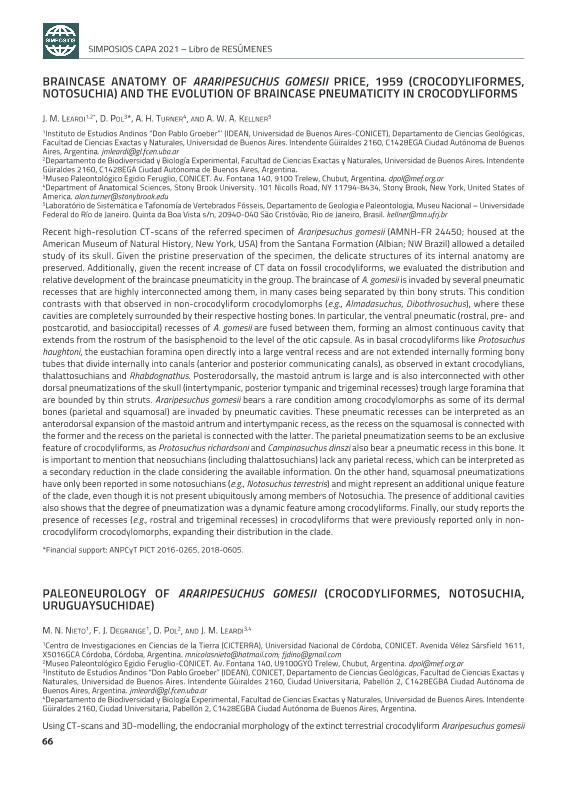Evento
Braincase anatomy of araripesuchus gomesii price, 1959 (crocodyliformes, notosuchia) and the evolution of braincase pneumaticity in crocodyliforms
Tipo del evento:
Congreso
Nombre del evento:
XII Congreso de la Asociación Paleontológica Argentina
Fecha del evento:
23/11/2021
Institución Organizadora:
Asociación Paleontológica Argentina;
Título de la revista:
Publicación Electrónica de la Asociación Paleontológica Argentina
Editorial:
Asociación Paleontológica Argentina
ISSN:
2469-0228
Idioma:
Inglés
Clasificación temática:
Resumen
Recent high-resolution CT-scans of the referred specimen of Araripesuchus gomesii (AMNH-FR 24450; housed at the American Museum of Natural History, New york, USA) from the Santana Formation (Albian; NW Brazil) allowed a detailed study of its skull. Given the pristine preservation of the specimen, the delicate structures of its internal anatomy are preserved. Additionally, given the recent increase of CT data on fossil crocodyliforms, we evaluated the distribution and relative development of the braincase pneumaticity in the group. The braincase of A. gomesii is invaded by several pneumatic recesses that are highly interconnected among them, in many cases being separated by thin bony struts. This condition contrasts with that observed in non-crocodyliform crocodylomorphs (e.g., Almadasuchus, Dibothrosuchus), where these cavities are completely surrounded by their respective hosting bones. In particular, the ventral pneumatic (rostral, pre- and postcarotid, and basioccipital) recesses of A. gomesii are fused between them, forming an almost continuous cavity that extends from the rostrum of the basisphenoid to the level of the otic capsule. As in basal crocodyliforms like Protosuchus haughtoni, the eustachian foramina open directly into a large ventral recess and are not extended internally forming bony tubes that divide internally into canals (anterior and posterior communicating canals), as observed in extant crocodylians, thalattosuchians and Rhabdognathus. Posterodorsally, the mastoid antrum is large and is also interconnected with other dorsal pneumatizations of the skull (intertympanic, posterior tympanic and trigeminal recesses) trough large foramina that are bounded by thin struts. Araripesuchus gomesii bears a rare condition among crocodylomorphs as some of its dermal bones (parietal and squamosal) are invaded by pneumatic cavities. These pneumatic recesses can be interpreted as an anterodorsal expansion of the mastoid antrum and intertympanic recess, as the recess on the squamosal is connected with the former and the recess on the parietal is connected with the latter. The parietal pneumatization seems to be an exclusive feature of crocodyliforms, as Protosuchus richardsoni and Campinasuchus dinszi also bear a pneumatic recess in this bone. It is important to mention that neosuchians (including thalattosuchians) lack any parietal recess, which can be interpreted as a secondary reduction in the clade considering the available information. On the other hand, squamosal pneumatizations have only been reported in some notosuchians (e.g., Notosuchus terrestris) and might represent an additional unique feature of the clade, even though it is not present ubiquitously among members of Notosuchia. The presence of additional cavities also shows that the degree of pneumatization was a dynamic feature among crocodyliforms. Finally, our study reports the presence of recesses (e.g., rostral and trigeminal recesses) in crocodyliforms that were previously reported only in non- crocodyliform crocodylomorphs, expanding their distribution in the clade.
Palabras clave:
CROCODYLOMORPHA
,
CROCODYLIFORMES
,
PNEUMATICITY
,
EVOLUTION
Archivos asociados
Licencia
Identificadores
Colecciones
Eventos(IDEAN)
Eventos de INSTITUTO DE ESTUDIOS ANDINOS "DON PABLO GROEBER"
Eventos de INSTITUTO DE ESTUDIOS ANDINOS "DON PABLO GROEBER"
Citación
Braincase anatomy of araripesuchus gomesii price, 1959 (crocodyliformes, notosuchia) and the evolution of braincase pneumaticity in crocodyliforms; XII Congreso de la Asociación Paleontológica Argentina; Buenos Aires; Argentina; 2021; 66-66
Compartir




